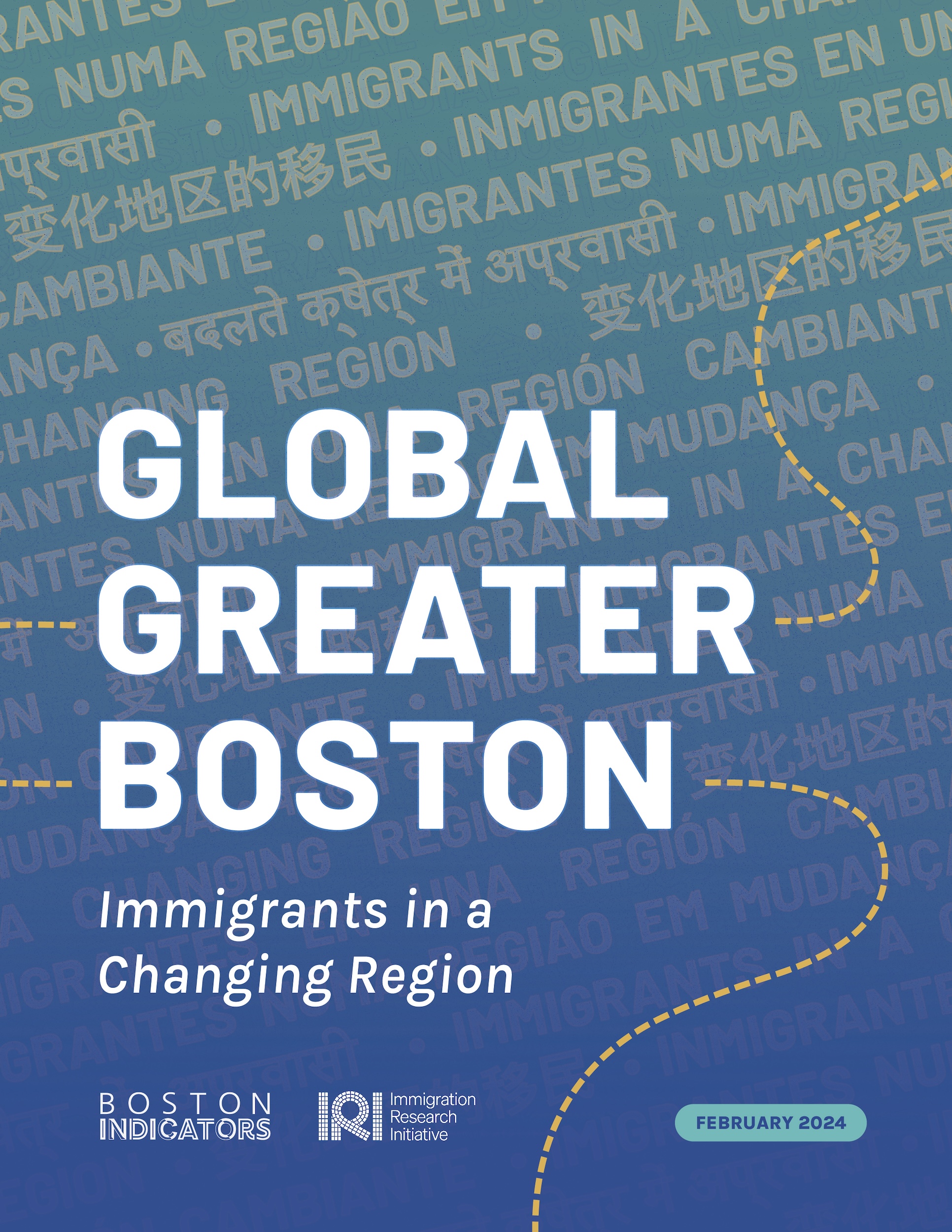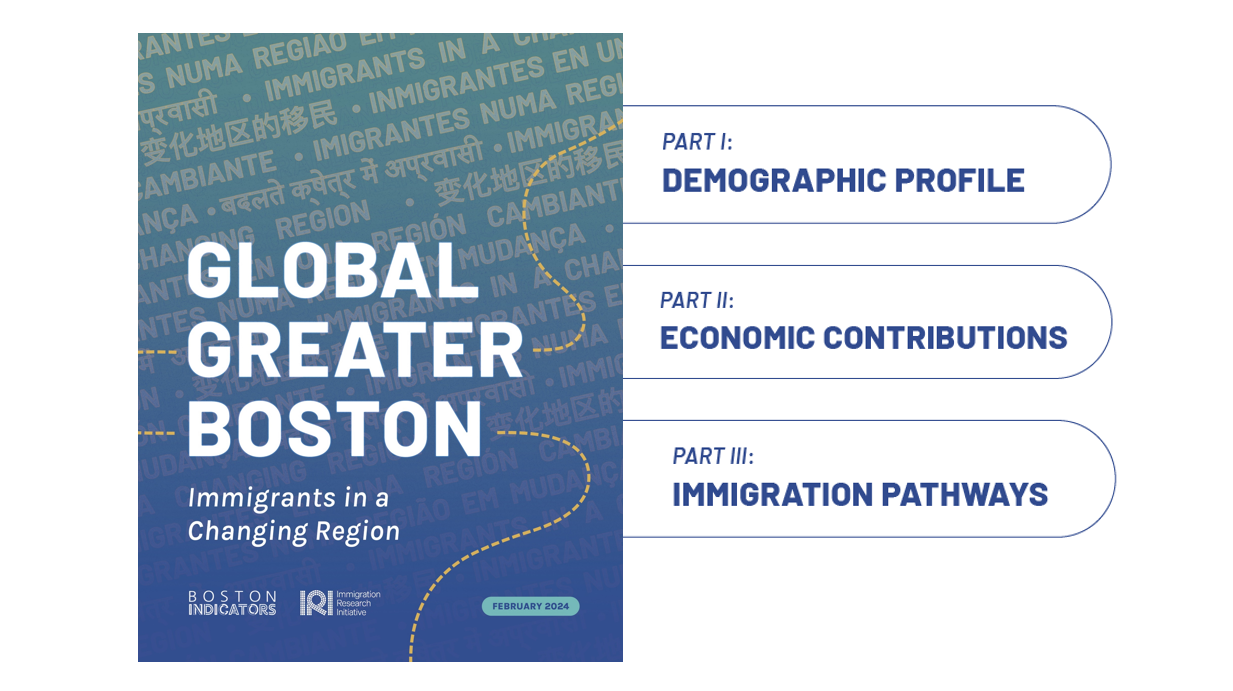New brief captures the state of Asian businesses in Massachusetts, highlights potential opportunities
June 21, 2023
Global Greater Boston, a report jointly written by Boston Indicators and New York City–based Immigration Research Initiative (IRI), was released with a public online presentation and forum on February 14. Subtitled “Immigrants in a Changing Region,” the report looks at demographic data defining migration trends to Greater Boston over the last century-plus, with an emphasis on recent decades, and economic data depicting the notable challenges, mobility, and outsized contributions of the region’s immigrant population.
Boston Indicators Senior Research Manager Kelly Harrington presented the demographic data, sharing key takeaways, including that the leading countries of origin for immigrants to our region changed dramatically a few decades after federal immigration reform in 1965; that without immigrants, Greater Boston’s overall population would have shrunk; and that while Boston is similar to peer-sized cities in the share of population that is foreign-born, it differs markedly in the birthplaces represented. Greater Boston boasts 58 percent of the Cape Verde–born population in the nation. Our Latino population is robust and varied, but unlike the rest of the country, very few people from Mexico settle here.
IRI Senior Data and Policy Analyst Anthony Capote then probed the data on economic outcomes and contributions of Greater Boston’s immigrants. These data defy old two-dimensional myths of a poverty-stricken monolith. Immigrants work in all sectors of the economy and make up 25 percent of the workforce. They are over-represented in some lower-income jobs; for example, holding 78 percent of maid/housekeeper jobs. At the same time, 61 percent of working immigrants are in medium- to high-wage jobs and business ownership is high, with 40 percent of “Main Street businesses”—car washes, salons, restaurants, convenience stores, etc.—owned by immigrants. Greater Boston’s immigrants are highly educated, with 24 percent holding graduate degrees and another 35 percent with at least some college. Looking closer at race and gender reveals that some old patterns have yet to be broken, and Latina and Black women are over-represented at the lower wage levels and White or AAPI male immigrants dominate the upper wage graphs. Overall, however, immigrants in Greater Boston are upwardly mobile, continuing to earn more the longer they are here, and seeing their children improve their economic status in the next generation.
IRI Senior Data and Policy Analyst Anthony Capote then probed the data on economic outcomes and contributions of Greater Boston’s immigrants. These data defy old two-dimensional myths of a poverty-stricken monolith. Immigrants work in all sectors of the economy and make up 25 percent of the workforce. They are over-represented in some lower-income jobs; for example, holding 78 percent of maid/housekeeper jobs. At the same time, 61 percent of working immigrants are in medium- to high-wage jobs and business ownership is high, with 40 percent of “Main Street businesses”—car washes, salons, restaurants, convenience stores, etc.—owned by immigrants. Greater Boston’s immigrants are highly educated, with 24 percent holding graduate degrees and another 35 percent with at least some college. Looking closer at race and gender reveals that some old patterns have yet to be broken, and Latina and Black women are over-represented at the lower wage levels and White or AAPI male immigrants dominate the upper wage graphs. Overall, however, immigrants in Greater Boston are upwardly mobile, continuing to earn more the longer they are here, and seeing their children improve their economic status in the next generation.
See the report to pore over more fascinating details on where people came from and where they live, what sectors they work in and how much they earn, and more!
Massachusetts Immigrant & Refugee Advocacy Coalition Director of Citizenship and Training Jessica Chicco offered a response after the data presentation, adding a few new stats from her organization’s work that account for recent arrivals from Afghanistan; Ukraine; Caribbean areas of unrest, especially Haiti; and the thousands of asylum or TPS seekers who ended up in Massachusetts after crossing the southern border. The updated state data for 2023 will capture a lot of history in a few numbers.
These numbers and their analysis are important, as Chicco noted, “to bust myths. We need to leverage data to advance policies that acknowledge the contributions of immigrant communities. We’ve made strides on things like driver licenses and in-state tuition for Massachusetts high school graduates. But still to come is better access to ESOL and job training, recognition of professional certifications from other countries, and so on.”
Boston Indicators Executive Director Luc Schuster moderated a conversation with Chicco and the authors, addressing the noneconomic contributions of immigrants (the food alone!); the policy recommendations that could help newcomers reach economic stability faster; and what makes Greater Boston unique or similar to other U.S. cities.
The online audience was highly engaged and shared commentary and questions that Schuster incorporated into the discussion. They appreciated the depth and specificity of the report. One commenter said, “I’ve worked in Boston’s Haitian community for 40 years and I’ve learned more this morning than in all that time. The census obscures Haitians in the larger Black population.”
Conversation gravitated to the dynamic that many who come here fleeing something terrible need public investment in the short term to get on their feet, but in the aggregate long term that investment is returned manyfold. Further, observed one commenter, those “short-term costs—for food, shelter, ESOL, job training—transfer to dollars that not only support immigrants’ entry to the workforce but are also paid to Massachusetts businesses/nonprofits and individuals for those services.” Capote pointed out that after their first five years in the country, immigrants contribute significantly to tax revenues, bringing in $350 million per 100,000 immigrants in year five.
While such numbers are useful to convince the ledger-keepers, such justifications can seem crass. As Capote summed up, “These are humans. We just need to recognize that when they succeed, we all do.”
Massachusetts Immigrant & Refugee Advocacy Coalition Director of Citizenship and Training Jessica Chicco offered a response after the data presentation, adding a few new stats from her organization’s work that account for recent arrivals from Afghanistan; Ukraine; Caribbean areas of unrest, especially Haiti; and the thousands of asylum or TPS seekers who ended up in Massachusetts after crossing the southern border. The updated state data for 2023 will capture a lot of history in a few numbers.
These numbers and their analysis are important, as Chicco noted, “to bust myths. We need to leverage data to advance policies that acknowledge the contributions of immigrant communities. We’ve made strides on things like driver licenses and in-state tuition for Massachusetts high school graduates. But still to come is better access to ESOL and job training, recognition of professional certifications from other countries, and so on.”
Boston Indicators Executive Director Luc Schuster moderated a conversation with Chicco and the authors, addressing the noneconomic contributions of immigrants (the food alone!); the policy recommendations that could help newcomers reach economic stability faster; and what makes Greater Boston unique or similar to other U.S. cities.
The online audience was highly engaged and shared commentary and questions that Schuster incorporated into the discussion. They appreciated the depth and specificity of the report. One commenter said, “I’ve worked in Boston’s Haitian community for 40 years and I’ve learned more this morning than in all that time. The census obscures Haitians in the larger Black population.”
Conversation gravitated to the dynamic that many who come here fleeing something terrible need public investment in the short term to get on their feet, but in the aggregate long term that investment is returned manyfold. Further, observed one commenter, those “short-term costs—for food, shelter, ESOL, job training—transfer to dollars that not only support immigrants’ entry to the workforce but are also paid to Massachusetts businesses/nonprofits and individuals for those services.” Capote pointed out that after their first five years in the country, immigrants contribute significantly to tax revenues, bringing in $350 million per 100,000 immigrants in year five.
While such numbers are useful to convince the ledger-keepers, such justifications can seem crass. As Capote summed up, “These are humans. We just need to recognize that when they succeed, we all do.”

Agenda
Welcome and Opening Remarks
Luc Schuster, Executive Director, Boston Indicators
Report Briefing
Kelly Harrington, Senior Research Manager, Boston Indicators
Anthony Capote, Senior Data & Policy Analyst, Immigration Research Initiative
Brief Report Response
Jessica Chicco, Director of Citizenship & Training, Massachusetts Immigrant & Refugee Advocacy Coalition
Discussion and Q&A

